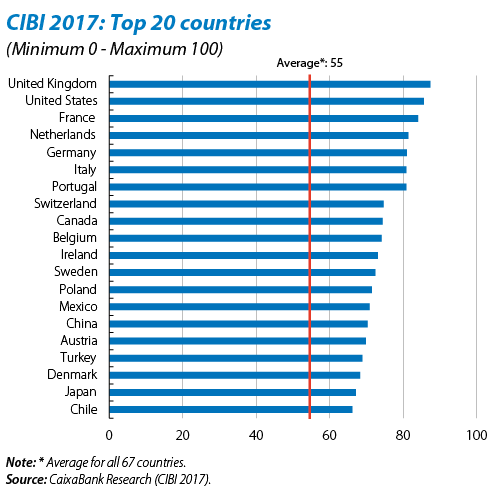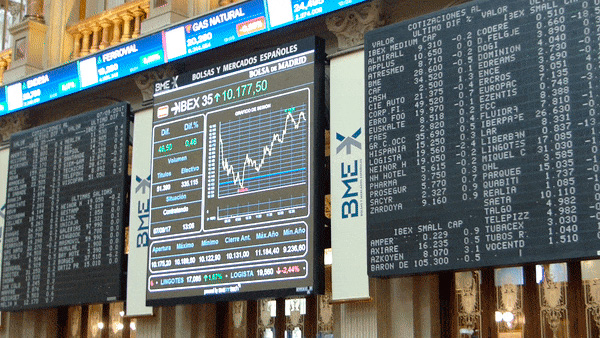Theme
The companies that comprise the Ibex 35, the benchmark index of the Madrid Stock Exchange, generated a record 67.7% of their revenues abroad in 2017.
Summary
In less than 30 years, Spain’s main listed companies, ranging from construction and engineering groups to banks, have established a significant presence on the global corporate stage. Their international revenues, as a share of total income, have more than doubled and in recent years have offset the downturn in their domestic market.
Analysis
Background
Corporate Spain was a late-comer to expanding abroad, beginning in earnest during the 1990s, following the country’s membership of the European Economic Community in 1986 that opened up the economy and gathered pace after Spain became a founding member of the euro zone in 1999. In less than 30 years, a bevy of Spanish companies and banks have built up a notable presence abroad. Their internationalisation began in Latin America, a natural choice given the cultural and linguistic affinities, and then moved to Europe, the US and more recently parts of Asia. Firms were also pulled by economic liberalisation and privatisation in many Latin American countries as this opened up sectors that were hitherto off-limits.
The expansion abroad also came after a wave of mergers, restructurings and privatisations in Spain that increased the critical mass of companies and banks. Spain has nine companies in the latest Fortune Global 500 ranking of the world’s largest companies based on total revenues, one of which, Banco Santander, is in the top 100 (see Figure 1). In 1995, when the ranking started, the only Spanish companies in the list were INI, the state-owned industrial holding, and Repsol, the oil and gas group.Figure 1. Spanish companies in the Fortune Global 500 ranking
| Rank | Company | Revenues (US$ bn) |
|---|---|---|
| 73 | Banco Santander | 82.8 |
| 153 | Telefónica | 57.5 |
| 223 | Banco Bilbao Vizcaya Argentaria | 43.7 |
| 281 | ACS | 36.9 |
| 306 | Repsol | 34.5 |
| 332 | Iberdrola | 32.3 |
| 417 | Gas Natural Fenosa | 26.1 |
| 426 | Mapfre Group | 25.8 |
| 428 | Inditex | 25.7 |
Source: Fortune.
Outward investment surged from a yearly average of US$2.3 billion in 1985-95 to US$44.3 billion in 1999 and a peak of US$137 billion in 2007, the third highest amount in the EU after the UK and Germany and the fourth in the world including the US, according to UNCTAD. Today, Spain’s stock of outward direct investment of US$516 billion (2016 figure) is higher than Italy’s (US$460 billion) and compared to a mere US$15.6 billion in 1990, but still far from the UK’s US$1.4 trillion, Germany’s US$1.3 trillion and France’s US$1.2 trillion.
Ibex 35 companies: onward and upward
The international expansion has been led by the main companies and banks listed on the Madrid Stock Exchange who together make up the Ibex 35 index. These range from construction and infrastructure companies to energy, engineering and telecoms. The share of their international revenues in total revenues has increased virtually every year and in 2017 reached a record 67.7%, up from 65.8% in 2016 and just 24% in 1997 (see Figure 2).Figure 2. International revenues of Ibex-35 companies, 2017 (€ million and % of total revenues)
Company | Sector | Total revenues (€ mn) (1) | International (% of total) |
|---|---|---|---|
| Abertis | Motorways | 5,136 | 74.0 |
| ACS | Construction & services | 34,898 | 87,3 |
| Acerinox | Metals | 4,627 | 89.7 |
| Aena | Consumer services | 3,961 | 5.4 |
| Amadeus | Technology | 4,852 | 95.0 |
| Acciona | Construction | 7,254 | 56.3 |
| Amadeus IT Holding | Travel technology | 3,418 | 95.0 |
| Bankia | Banking | 2,309 | 0.1 |
| Bankinter | Banking | 1,289 | 8.3 |
| BBVA | Banking | 29,296 | 82.6 |
| Caixabank | Banking | 6,970 | 6.0 |
| Cellnex | Technology | 758 | 44.0 |
| Inmobiliaria Colonial | Real estate | 283 | 69.1 |
| Día | Supermarket chain | 8,620 | 44.4 |
| Enagás | Energy | 1,360 | 0.2 |
| Endesa | Energy | 19,556 | 9.7 |
| Ferrovial | Construction | 12,208 | 76.8 |
| Gas Natural | Energy | 23,306 | 53.8 |
| Grifols | Pharmaceutical | 4,318 | 94.4 |
| IAG | Transport | 21,329 | 86.5 |
| Iberdrola | Energy | 31,263 | 57.6 |
| Inditex | Consumer goods | 25,336 | 83.7 |
| Indra | Technology | 3,012 | 53.9 |
| Mapfre | Insurance | 19,309 | 65.4 |
| Mediaset | Consumer services | 986 | 2.9 |
| Melia | Consumer services | 1,885 | 52.7 |
| Merlin | Real estate | 463 | 2.3 |
| Red Eléctrica | Energy | 1,941 | 2.2 |
| Repsol | Energy | 41,668 | 50.3 |
| Banco Sabadell | Banking | 4,840 | 34.7 |
| Banco Santander | Banking | 56,041 | 87.3 |
| Siemens Gamesa | Engineering | 6,538 | 97.5 |
| Técnicas Reunidas | Engineering | 5,068 | 98.6 |
| Telefónica | Telecoms | 52,007 | 75.6 |
| Viscofan | Consumer goods | 778 | 86.2 |
| Total | 443,468 | 67.7 |
(1) Figures rounded to nearest whole number.
Source: BME Spanish Exchanges. Data from the National Securities Market Commission (CNMV).
The rising share of the international revenues of these companies –Spain’s multinationals– has helped to offset the downturn in their domestic market. Economic output, hit by the bursting of a massive property bubble as of 2008 and the global financial crisis, did not recover its pre-crisis level until the second quarter of last year. During this period, exports rose from €189.2 billion in 2008 to a record €277.1 billion in 2017. Exports relative to GDP are now 10 percentage points above 2007 levels.
Although the international revenues of the Ibex 35 companies include exports, the great bulk of their income comes from the revenues generated by their subsidiaries abroad. Most of Spain’s big exporters, such as car and chemical producers, are multinationals from other countries.
The Ibex 35 company whose share of international revenues in its total income was the highest was the engineering group Técnicas Reunidas (98.6%), followed by the wind energy leader Siemens Gamesa (97.5%), the travel technology group Amadeus (95%), and the steel producer Acerinox (close to 90%). Acciona, the infrastructure and renewable energy company, increased its share of international revenues from 48.4% to 56.3% and the bank BBVA from 78.5% to 82.6%, while those of Santander dropped a little from 89.8% to 87.3%.
Santander’s international revenues were the highest in absolute terms at €48,923 million. They as well as profits are fairly evenly balanced between mature and developing economies (see Figure 3).Figure 3. Countries’ contribution to Santander’s underlying group profit, 2017 (%)
| % | % | ||
|---|---|---|---|
| Brazil | 26 | Portugal | 5 |
| UK | 16 | Argentina | 4 |
| Spain | 15 | US | 4 |
| Santander Consumer Finance | 13 | Poland | 3 |
| Mexico | 7 | Other countries | 1 |
| Chile | 6 |
Source: Santander.
Santander took an original approach to internationalisation. Instead of a forging a big presence around the world in order to service companies and facilitate trade, which was the way of HSBC, for example, or focusing on investment banking from various key financial centres like JPMorgan Chase in New York, London and Hong Kong, it pioneered global retail banking with a significant presence in Brazil, Mexico, the UK and Spain. It is the euro zone’s largest bank by market capitalisation and the 14th biggest in the world, with 133 million clients.
The bank has made US$80 billion of acquisitions abroad and in Spain, its latest being its ailing rival on its home ground, Banco Popular, which it bought for a symbolic €1 last June in a deal masterminded by EU regulators to avoid a damaging collapse.
BBVA, Spain’s second largest bank, has followed a similar route to Santander’s. Mexico provided 28% of gross income last year, South America 18%, Turkey 16% and the US 12%.
The sector that has internationalised the most is construction, particularly in the field of transport infrastructure. ACS generated 87% of its revenues abroad in 2017, Ferrovial 76%, Abertis 74% and Acciona 56%. The first three of these companies and two more, Sacyr and Globalvia, are among the world’s 10-largest transport developers, more than any other country, and four of them are in the Top 10 on the basis of invested capital (see Figures 4 and 5).Figure 4. Ranking of the world’s 10-largest transport developers (1)
| Operating or under construction | Of which: in the US | Of which: in Canada | Of which: in home country | All other | |
|---|---|---|---|---|---|
| 1. ACS Group/Hochtief (Spain) | 59 | 4 | 10 | 17 | 28 |
| 2. Vinci (France) | 47 | 1 | 3 | 17 | 26 |
| 3. Abertis (Spain) | 45 | 0 | 0 | 14 | 31 |
| 4. Macquarie (Australia) | 41 | 3 | 1 | 1 | 36 |
| 5. Ferrovial/Cintra (Spain) | 39 | 4 | 3 | 11 | 21 |
| 6. Sacyr (Spain) | 33 | 0 | 0 | 13 | 20 |
| 7. Meridiam (France) | 30 | 7 | 3 | 3 | 17 |
| 8 Globalvia (Spain) | 28 | 1 | 0 | 16 | 10 |
| 9. John Laing (UK) | 25 | 3 | 0 | 14 | 8 |
| 10. Egis (France) | 25 | 0 | 1 | 6 | 18 |
(1) Developers are ranked by the number of road, rail, port and airport concessions over US$50mn in investment value that they have developed worldwide, alone or in joint venture since 1985, and are currently operating or have under construction as of 1/X/2017.
Source: Public Works Financing.Figure 5. Developers ranked by invested capital (1985-2017)
| Total invested capital (US$ mn) (1) | |
| ACS (Iridium+Hochtief) (Spain) | 94,900 |
| Ferrovial (Cintra) (Spain) | 89,200 |
| Vinci (France) | 82,500 |
| Macquaire (Australia) | 53,550 |
| Meridiam (France) | 48,250 |
| Bouygues (France) | 44,500 |
| John Laing (UK) | 35,900 |
| Sacyr (Spain) | 32,500 |
| Egis (France) | 27,800 |
| Globalvia (Spain) | 27,300 |
| OHL (Spain) | 21,200 |
(1) Total invested capital is the sum of the original investment, in nominal dollars, of all of a company’s transport P3 projects (highways, transit, ports and airports) from 1985 to 1/X/2017. Projects are counted in a company’s total when it had a substantial role as a developer in financing, building and operating a publicly owned asset, or in acquiring and improving/operating an asset for a set amount of time, under a long-term contract with government. To capture all of a firm’s development experience we include we count projects that are currently in a firm’s portfolio and those that have been sold or reverted to government operation. The numbers may reflect some double counting on the largest P3 projects where there is co-investment by a consortium of developers.
Source: Public Works Financing.
Hardly a month goes by without one of these companies winning a major contract abroad. So far this year, ACS has won a €3.3 billion contract for Montreal’s automatic passenger transport system, a €145 million bridge contract in Boston and a €1 billion hydroelectric contract in Canada, while Siemens Gamesa was contracted to supply an additional 120 MW of capacity for Taiwan’s offshore wind power plant.
After four years when gross investment abroad excluding special purpose vehicles (ie, productive investment) averaged €31 billion and net investment (after divestments) €16.8 billion, last year saw a 47% fall in gross investment to €19.7 billion and net investment plummeted 138% mainly because of a divestment in the financial services sector (see Figure 6).Figure 6. Spanish investment abroad, 2013-17 (€ billion) (1)
| Gross investment | Net investment | |
|---|---|---|
| 2013 | 25.9 | 14.1 |
| 2014 | 31.7 | 9.7 |
| 2015 | 31.7 | 17.5 |
| 2016 | 37.3 | 26.1 |
| 2017 | 19.8 | -9.8 |
(1) Excluding special purpose vehicles (SPEs) and hence productive investment.
Source: Registry of Foreign Investments.
The US was the favoured destination of gross investment in 2017 with €2.8 billion (14.2% of the total), while investment in the UK fell from €8.9 billion in 2016 (24% of the total) to €571 million (see Figure 7).Figure 7. Spanish investment abroad by top 10 countries, 2016-17 (€ million and %)
| 2016 | 2017 | |||
|---|---|---|---|---|
| Gross investment | % of total | Gross investment | % of total | |
| US | 5,091 | 13.7 | 2,801 | 14.2 |
| France | 433 | 1.2 | 2,795 | 14.1 |
| Mexico | 643 | 1.7 | 1,721 | 8.7 |
| Canada | 481 | 1.3 | 1,567 | 7.9 |
| Netherlands | 2,174 | 5.8 | 1,487 | 7.5 |
| Colombia | 466 | 1.3 | 1,476 | 7.5 |
| Brazil | 1,537 | 4.1 | 1,055 | 5.3 |
| Portugal | 452 | 1.2 | 975 | 4.9 |
| Ireland | 4,206 | 11.3 | 946 | 4.8 |
| UK | 8,905 | 23.9 | 571 | 2.9 |
Source: Registry of Foreign Investments.
Whether the fall in the country which has the highest share of Spanish investment (18.9%) was due to companies putting investment decisions on hold until the outcome of the Brexit negotiations is known or because the 2016 figure was exceptionally high is not clear.
CaixaBank’s 2017 Index for Business Internationalisation (CIBI), published earlier this year, again put the UK at the top of its ranking, despite the uncertainty over Brexit, although a preliminary agreement on exit terms was reached at the end of last year and terms were agreed in March for a transition period (see Figure 8).
The index, however, is based on current and not future conditions. It is built on five pillars: the degree of accessibility to the market of each country; the ease of operating in each market; that market’s commercial attractiveness; the financial environment; and the macroeconomic and institutional stability.

Emboldened by its success in running Spain’s airports (which received a record 249.2 million passengers in 2017), Aena, 51% owned by the state, is casting an eye on stepping up its internationalisation. This could see the company, which generates less than 6% of its revenues abroad, bidding in the privatisation of seven Japanese airports on the island of Hokkaido.
Conclusion
The internationalisation of Spain’s largest companies is now well consolidated and shows no signs of letting up.
William Chislett
Associate Analyst, Elcano Royal Institute | @WilliamChislet3



